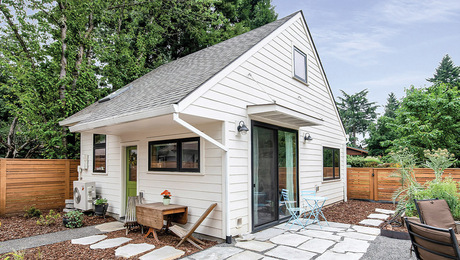*
I’ve been building a second story deck for a client who wanted a waterproof subfloor and trad. decking above. I was told by my local supplier that a high grade flooring adhesive who work fine for attaching the 2×4 treated sleepers to the torch down membrane(modified bitumen). This has not worked. As my hunch should have told me the adhesive didn’t bond well with the petroleum based membrane. I’d prefer not to penetrate the membrane with traditional fasteners for obvious reasons. Any one have experience with this issue? I’d love the input!!!
Sincerely,
Jared Bonea



















Replies
*
Jared, do you have to fasten the sleepers to the deck? Or can they float attached to a frame that's attached to the house?
chrs, GO
*Well, I'll tell you what a guy could do... You may have to use "traditional fasteners" through the torch down and then use that old roofer's friend, messy black mastic, to seal it up. That messy stuff should last a good 20 years if it's on thick enough (about1/2"). Don't worry about it looking bad since it'll be under the decking. Another option is to fasten the sleepers to the torch down deck and then build small cants around them and put more torch down over the cants/sleepers to seal them in. Attatch your decking with beads of mastic to seal around the deck fasteners.But what do I know...I'm a roofer, I don't build decks. Say hi to Christoph for me. Also check out my discussion in Knots on that old plane I showed you. It's under Tools for Woodworking titled "What's the history and age of my old wooden plane?"
*The answer is .......... you don't. We have built many a floating deck that is attached to nothing. All wear boards on top are screwed to the sleepers below with 2 1/2" screws through 1 1/2" deck boards. The weight of the deck keeps it down and solid. We do ours over rubber with a piece of scrap rubber glued to the bottom of each sleeper. You could do the same with a piece of non-granular modified bitumen. Don't use rubber as it's not compatible with asphalts.
*Thanks Tim,Exactly what I needed to know!!Jared
*Definitely don't use Jeffrey's (sorry, Jeff) suggestion to use tar plastic mastic. It contains volatile compound that can eat the modified bitumenm or EPDM.I cut strips of EPDM about two inches wider than the sleepers, and use the caulking provided for the product as used at seams, etc. I tack the strips down with a dab every two feet or so, just enough so they don't blow away, and then tack the sleepers to the strips at alternating locations. The strips are just to keep wear and tear from abusing the roof surface. If it is a high wind area or hurricane codes prevail, you'll need to design a hurricane clip or fastener at the roof edges which can look good as a trim, too.
*Im building a deck over a single membrane flat roof and the architect has stipulated styrofoam blocks under the sleepers. The weight of the deck is all that is needed to keep it there. The trick for me is a method for attaching posts (to attach handrail) to the deck.
*That's what architects are for - specifying just enough to creat a problem, and then walking away from it. He should solve it. That's what he's getting the big money for!That said, there are Simpson and other hardware available for the task. The reason you need to make him specify this is that the railing needs to rresist at least 200 (or is it 250?) pounds of outward thrust. These guys are great at documentation, to be able to pass the blame later. I'll bet dollars to donuts that the docs say something to the effect of "If it ain't clear, ask me"! So ask. Have a nice friendly chat with him, swapping opinions and possibilities of ways to do it, while making clear that you need him to get you something in writing, such as a scketch and memo specing it. I know how to do it and it can be done but make him do his homework or the liability is yours. Just be friendly with him because adversaial relationships with designers and architects rarely work well for builders.BTW you might want to point out that styrafoam will degrade over time if there is ANY exposure to UV rays of the sun. Ask if there is an alternate method he would accept. I can imagine this after ten years getting bruised and pounded down in the traffic arreas but not other locations so the roof deck gets a trampoline bounce to it.
*Yo MauriceDo not use styrofoam. It will deteriorate.Go to your reputable roofing supply house and ask for water transmitting filter fabric made specifically to transmit the water under your sleepers and to the edge of the roof. You may have to be persistent but this stuff works. It protects the torchdown and gets rid of the water.For post anchors I weld my own and install them as I install the roofing, making them watertight. If the roof is already down, you can do the same thing only you'll have to surround each base with a pitch pan. This is just a metal box into which you pour a liquid rubber to seal your fastening penetrations. Ask your roofing supplier. Rule #1 is no petroleum products on a torchdown roof.
*Thanks Terry,Will check it out at the roofing retailer here in Toronto. I will talk to the architect as well.Thanks
*
I've been building a second story deck for a client who wanted a waterproof subfloor and trad. decking above. I was told by my local supplier that a high grade flooring adhesive who work fine for attaching the 2x4 treated sleepers to the torch down membrane(modified bitumen). This has not worked. As my hunch should have told me the adhesive didn't bond well with the petroleum based membrane. I'd prefer not to penetrate the membrane with traditional fasteners for obvious reasons. Any one have experience with this issue? I'd love the input!!!
Sincerely,
Jared Bonea